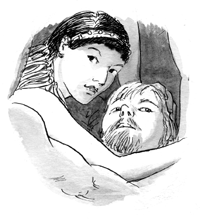
|
|
Pocahontas Revealed
|

|
|
Program Overview
|

|
 NOVA brings together ancient artisans, historians, and archeologists
to provide a fresh look at the myth of Pocahontas.
NOVA brings together ancient artisans, historians, and archeologists
to provide a fresh look at the myth of Pocahontas.
The program:
-
reviews how Virginia's Jamestown became the first permanent
English settlement in the New World in 1607.
-
recounts that Captain John Smith and other English settlers came
to America to hunt for exploitable resources.
-
notes that the English settlers planned to trade goods for food
with the Indians* rather than grow their own.
-
recounts how Smith came to be captured by the Indians and was
eventually taken to their political center, Werowocomoco.
-
presents Smith's recollection of the historical
meeting—written 17 years after it occurred—that took
place between him and Chief Powhatan in which Pocahontas
reportedly saved his life.
-
traces how archeologists determined where the Werowocomoco site
was and documents key findings indicating the location of the
longhouse in which the fabled meeting is said to have taken
place.
-
states that copper was found at the longhouse site and shows the
process by which scientists used a spectrometer to determine it
was English copper.
-
notes how adoption rituals may have played a role in what
happened between Smith and Pocahontas.
-
recalls how Pocahontas brought food to the English settlers at a
time when Jamestown was on the verge of collapse and relates how
Indians may have lived at the Jamestown fort for a time.
-
provides a reason for why the Indians stopped providing food to
the settlers—tree-ring research revealed that a seven-year
drought had begun.
-
states how English settlers used weapons to start a war with the
Indians, eventually forcing Chief Powhatan and his people to
move.
-
recounts Smith's return to England following an injury and
recalls how Pocahontas was told he had died.
-
relates Pocahontas' eventual capture by the English and her
conversion to Christianity and marriage to John Rolfe.
-
follows Pocahontas' return to England where she discovers Smith
is still alive and reveals what took place when they were
reunited.
* The word "Indians" or "Virginia Indians" is used in this
documentary because that was the preference of the people in the
program when referred to as a group. When referred to as
individuals, they prefer to be called by their specific nation,
tribe, or district names.
Taping Rights: Can be used up to one year after the program
is taped off the air.
|

|
